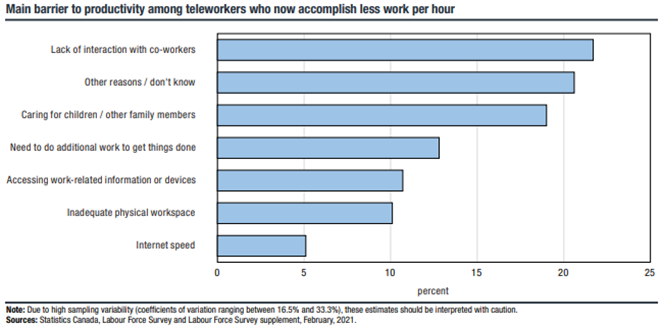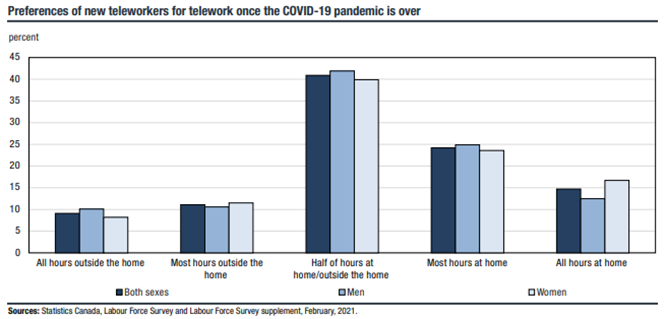Statistics Canada recently released a study on new teleworkers, employees who usually worked out of their homes before the COVID-19 pandemic, but worked most of their hours at home during the week of February 14 to 20, 2021. To what extent are teleworkers more or less productive? What are the main obstacles to productivity? How many Canadians would prefer to work from home after the COVID-19 pandemic is over? Read the highlights.
A little over a year ago, Canada entered an economic shutdown that substantially altered the work arrangements of thousands of workers. At the beginning of 2021, 32% of Canadian employees aged 15 to 69 worked most of their hours from home, compared with 4% in 2016.
As noted in the recent release of the Labour Force Survey, 3.1 million Canadians were working from home temporarily in response to the COVID-19 pandemic as of February 2021.
Here are their behaviours and feelings.
As productive at home as they were at their usual place of work
Of all new teleworkers, 90% reported being at least as productive, i.e., accomplishing at least as much work per hour, at home as they were previously at their usual place of work.
More than half (58%) reported accomplishing about the same amount of work per hour, while roughly one-third (32%) reported accomplishing more work per hour. The remaining 10% mentioned that they accomplished less work per hour while working at home than they did previously at their usual place of work.
The likelihood of accomplishing more work per hour varied across industries. For example, the percentage of new teleworkers who reported doing more work per hour was relatively high in public administration (41%) and health care and social assistance (45%). In contrast, the corresponding percentage amounted to 31% in goods-producing industries.
Regardless of age, educational attainment, marital status, industry, occupation, and whether or not they have children, men and women tended to report to a similar extent being at least as productive at home as they were in the past at their usual place of work.
These findings are in line with those of a recent U.S. study (Barrero, Bloom and Davis 2020), which shows that 85% of U.S. workers report being at least as efficient at home during the COVID-19 pandemic as they were on business premises before the pandemic.
More work hours per day
Large proportions of individuals who accomplish more work per hour (48%) and of individuals who do less work per hour (44%) reported working longer hours per day than they did in the past. Furthermore, virtually none of the workers who accomplish at least as much work per hour at home as they did previously now work shorter hours per day.
Overall, 35% of all new teleworkers reported working longer hours, with managers doing so in greater proportions (51%).
What are the barriers to productivity?
Employees who reported accomplishing less work per hour while working from home identified different barriers to productivity.
About one in five of those who reported being less productive than prior to the pandemic reported a lack of interaction with co-workers as the main reason why they accomplished less work per hour.
Close to 20% reported having to care for children or other family members. The remainder faced different challenges, such as accessing work-related information or devices (11%), having to do additional work to get things done (13%), having an inadequate physical work space (10%), or experiencing difficulty with Internet speed (5%).

Preferences for telework are diverse
Overall, 80% of new teleworkers indicated that they would like to work at least half of their hours from home once the pandemic is over.
In fact, 41% indicated that they would prefer working about half of their hours at home and the other half outside the home, while 39% would prefer working most (24%) or all (15%) of their hours at home. The remaining 20% would prefer working most (11%) or all (9%) of their hours outside the home.

Men and women mentioned that they would like to work at least half of their hours from home in fairly similar proportions. The diversity of preferences for telework observed in the aggregate was also found regardless of the socioeconomic group considered.




